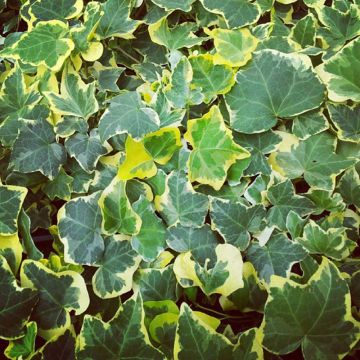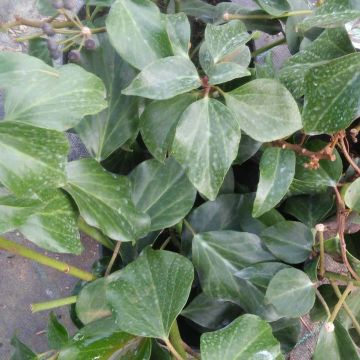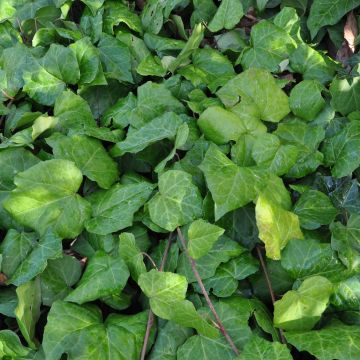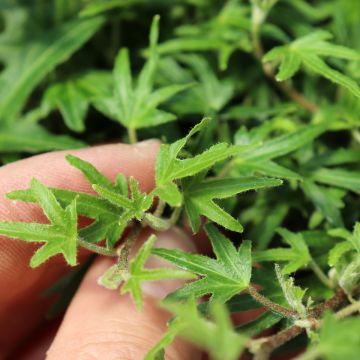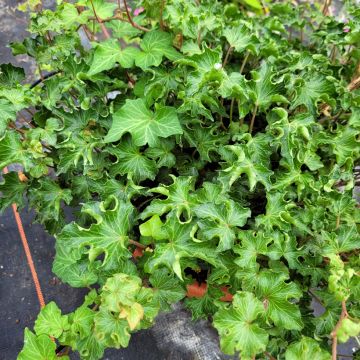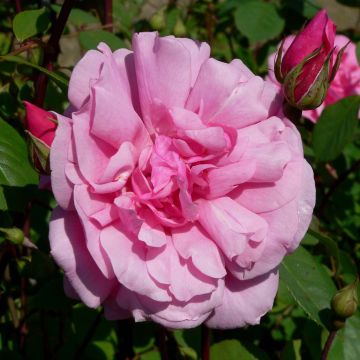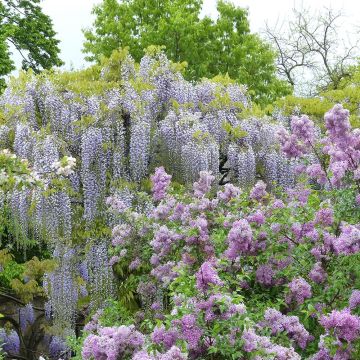

Hedera helix ObelixHedera helix Kappeln - Common ivy
Hedera helix ObelixHedera helix Kappeln - Common ivy
Hedera helix Obelix
English ivy, Common ivy
This item cannot be shipped to the selected country
Delivery charge from €5.90
More information
Schedule delivery date,
and select date in basket
This plant carries a 6 months recovery warranty
More information
We guarantee the quality of our plants for a full growing cycle, and will replace at our expense any plant that fails to recover under normal climatic and planting conditions.
From €5.90 for pickup delivery and €6.90 for home delivery
Express home delivery from €8.90.
Does this plant fit my garden?
Set up your Plantfit profile →
Description
Hedera helix 'Obelix' is a climbing cultivar of the common ivy that will charm with the beauty of its evergreen foliage, both imposing and delicate. This ornamental ivy variety is particularly appreciated for its ability to quickly and beautifully cover vertical surfaces. Used in gardens or in pots, it easily adapts to different environments, combining aesthetics and functionality. Its cold resistance and robustness also make this ivy a low-maintenance plant.
Ivies belong to the Araliaceae family making them cousins of Ginseng and fatsias. Hedera helix 'Obelix' comes from common ivy, found everywhere in forests, countryside, and gardens and native to the entire temperate Eurasian zone of the northern hemisphere. Ivy stems attach themselves to supports using powerful climbing roots. This plant has produced numerous cultivars of varying sizes, with diverse foliage, some capable of flowering and fruiting once mature. The foliage borne by the stems that will flower, located higher on the plant, is different from the foliage borne by the juvenile stems. Ivy's greenish flowering, in the form of globular inflorescences, is an excellent nectar source for bees. It is followed by black-blue berries, toxic to humans but an excellent winter food source for birds.
Hedera helix 'Obelix' is a cultivar derived from the 'Classy Lassie' variety. Its vigorous growth and climbing habit allow it to reach 3 m in height when supported by a trellis or suitable structure. The leaves of this plant are relatively large, measuring around 6 cm wide by 10 cm long. They have prominent veins, and the leaf margin is often wavy to curly. Their colour is a bright green.
Hedera helix 'Obelix' has rather long internodes, giving it a slightly sparse appearance compared to other ivy varieties. Its branches bear few leaves, but they are imposing enough to create an attractive visual effect. Although this ivy is not particularly known for its flowers, it can produce discreet inflorescences, followed by small black fruits. However, it is mainly cultivated for its dense and evergreen foliage. The bark, on the other hand, remains relatively discreet, playing a minor role in the plant's overall appeal.
Report an error about the product description
Plant habit
Flowering
Foliage
Safety measures
Botanical data
Hedera
helix
Obelix
Araliaceae
English ivy, Common ivy
Cultivar or hybrid
ingestion
Cette plante est toxique si elle est ingérée volontairement ou involontairement.
Ne la plantez pas là où de jeunes enfants peuvent évoluer, et lavez-vous les mains après l'avoir manipulée.
Pensez à conserver l'étiquette de la plante, à la photographier ou à noter son nom, afin de faciliter le travail des professionnels de santé.
Davantage d'informations sur https://plantes-risque.info
Other Hedera - Ivy
Planting and care
Hedera helix 'Obelix', easy to grow in regular soil, can be planted all year round except during frost or heatwaves. It prefers a fertile soil, quite rich in humus, moist, but well-drained. It is very accommodating to the presence of limestone or clay if the soil is well worked, also tolerating slightly acidic soils. This ivy is quite drought-resistant once established.
Plant it preferably against a wall, in a semi-shaded position or at the base of a sufficiently vigorous tree. Monitor watering during the first 2 years after planting, especially in case of a dry summer. To promote young shoots more quickly, fix the first ones to the ground (layering). You can rejuvenate the base by removing old branches. Prune regularly to shape it.
Planting period
Intended location
Care
This item has not been reviewed yet - be the first to leave a review about it.
Foolproof climbers
Haven't found what you were looking for?
Hardiness is the lowest winter temperature a plant can endure without suffering serious damage or even dying. However, hardiness is affected by location (a sheltered area, such as a patio), protection (winter cover) and soil type (hardiness is improved by well-drained soil).

Photo Sharing Terms & Conditions
In order to encourage gardeners to interact and share their experiences, Promesse de fleurs offers various media enabling content to be uploaded onto its Site - in particular via the ‘Photo sharing’ module.
The User agrees to refrain from:
- Posting any content that is illegal, prejudicial, insulting, racist, inciteful to hatred, revisionist, contrary to public decency, that infringes on privacy or on the privacy rights of third parties, in particular the publicity rights of persons and goods, intellectual property rights, or the right to privacy.
- Submitting content on behalf of a third party;
- Impersonate the identity of a third party and/or publish any personal information about a third party;
In general, the User undertakes to refrain from any unethical behaviour.
All Content (in particular text, comments, files, images, photos, videos, creative works, etc.), which may be subject to property or intellectual property rights, image or other private rights, shall remain the property of the User, subject to the limited rights granted by the terms of the licence granted by Promesse de fleurs as stated below. Users are at liberty to publish or not to publish such Content on the Site, notably via the ‘Photo Sharing’ facility, and accept that this Content shall be made public and freely accessible, notably on the Internet.
Users further acknowledge, undertake to have ,and guarantee that they hold all necessary rights and permissions to publish such material on the Site, in particular with regard to the legislation in force pertaining to any privacy, property, intellectual property, image, or contractual rights, or rights of any other nature. By publishing such Content on the Site, Users acknowledge accepting full liability as publishers of the Content within the meaning of the law, and grant Promesse de fleurs, free of charge, an inclusive, worldwide licence for the said Content for the entire duration of its publication, including all reproduction, representation, up/downloading, displaying, performing, transmission, and storage rights.
Users also grant permission for their name to be linked to the Content and accept that this link may not always be made available.
By engaging in posting material, Users consent to their Content becoming automatically accessible on the Internet, in particular on other sites and/or blogs and/or web pages of the Promesse de fleurs site, including in particular social pages and the Promesse de fleurs catalogue.
Users may secure the removal of entrusted content free of charge by issuing a simple request via our contact form.
The flowering period indicated on our website applies to countries and regions located in USDA zone 8 (France, the United Kingdom, Ireland, the Netherlands, etc.)
It will vary according to where you live:
- In zones 9 to 10 (Italy, Spain, Greece, etc.), flowering will occur about 2 to 4 weeks earlier.
- In zones 6 to 7 (Germany, Poland, Slovenia, and lower mountainous regions), flowering will be delayed by 2 to 3 weeks.
- In zone 5 (Central Europe, Scandinavia), blooming will be delayed by 3 to 5 weeks.
In temperate climates, pruning of spring-flowering shrubs (forsythia, spireas, etc.) should be done just after flowering.
Pruning of summer-flowering shrubs (Indian Lilac, Perovskia, etc.) can be done in winter or spring.
In cold regions as well as with frost-sensitive plants, avoid pruning too early when severe frosts may still occur.
The planting period indicated on our website applies to countries and regions located in USDA zone 8 (France, United Kingdom, Ireland, Netherlands).
It will vary according to where you live:
- In Mediterranean zones (Marseille, Madrid, Milan, etc.), autumn and winter are the best planting periods.
- In continental zones (Strasbourg, Munich, Vienna, etc.), delay planting by 2 to 3 weeks in spring and bring it forward by 2 to 4 weeks in autumn.
- In mountainous regions (the Alps, Pyrenees, Carpathians, etc.), it is best to plant in late spring (May-June) or late summer (August-September).
The harvesting period indicated on our website applies to countries and regions in USDA zone 8 (France, England, Ireland, the Netherlands).
In colder areas (Scandinavia, Poland, Austria...) fruit and vegetable harvests are likely to be delayed by 3-4 weeks.
In warmer areas (Italy, Spain, Greece, etc.), harvesting will probably take place earlier, depending on weather conditions.
The sowing periods indicated on our website apply to countries and regions within USDA Zone 8 (France, UK, Ireland, Netherlands).
In colder areas (Scandinavia, Poland, Austria...), delay any outdoor sowing by 3-4 weeks, or sow under glass.
In warmer climes (Italy, Spain, Greece, etc.), bring outdoor sowing forward by a few weeks.

































